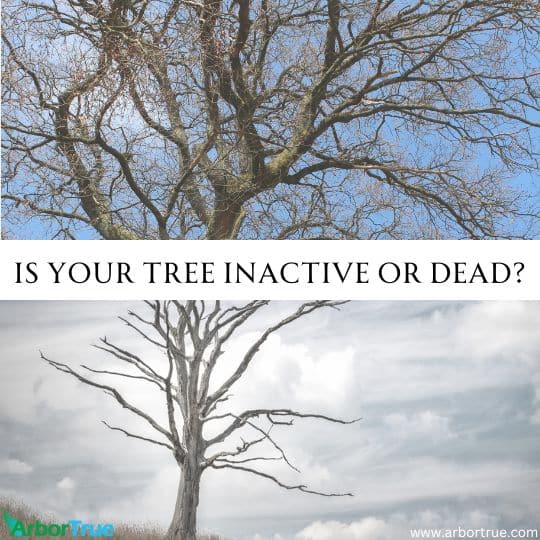
Three Ideas After the First Cold Front
November 8, 2023
Mushroom Monday: Honey Fungus
November 14, 2023

Understanding Your Tree: Is it Inactive or Dead?
You may have experienced this before. You have a tree in your landscape, and it’s the cold season, and something about it is different. The tree has no leaves, and it might look like the other trees around it, but for some reason you aren’t sure. The tree seems different, and you can’t tell if it’s inactive or, unfortunately, if the tree is dead.
Before looking at this, it’s important to look at why trees become inactive (or dormant). In a cold season, a tree reduces its activity because the conditions around it are changing. These include things like the temperature and the amount of light. A tree goes dormant, essentially slowing or stopping its growth, to reserve its energy and protect itself from these conditions so that it can survive until spring. It is a natural process and something many trees do.
When trying to determine whether a tree you have questions about is inactive or dead, there is a word of caution. While there are some things you can look for, and you can get an idea, this determination is best left to a professional arborist. A professional arborist, like those with ArborTrue, has the knowledge, skills, and experience to make an accurate determination of the condition of your tree. They can tell you its condition, what caused it, and what steps you might need to take. If your tree is dead they can make recommendations for removal and they can help you determine if there is any impact to other trees in your landscape.
Although determining the specific condition of your tree is something for the professionals, you can get an idea so that you can ask better questions and give a professional arborist more information. There are a number of steps you can take that can help you gather more information
What kind of tree is it?
The first piece of information that would be helpful would be knowing what kind of tree you have. This might be something you already know or you might have to do some research. You can note characteristics of the tree and maybe take photos. An internet search can be helpful or could ask someone at a nursery or garden center. Of course, a trained arborist can tell you what kind of tree you have. You might not be able to determine exactly what kind of tree you have by yourself, but you might be able to narrow it down some, and that can be a helpful start.
Compare
Once you have an idea of the kind of tree you have, the next step you can take is to compare it. How does your tree look compared to the same or similar kinds of trees that are inactive? Does your tree look the same or are there notable differences? You might be able to find similar trees in your or nearby landscapes or you can look for photographs online.
Another thing you can compare the tree to is its past history. Does the tree normally go visibly inactive, or is it an evergreen that normally retains its leaves in a cold season? If your tree normally goes visibly inactive, did it follow the normal process that it usually goes through, for example by having its leaves change color and falling off gradually, or was something different? Comparing things these ways can help you better understand if something unusual has happened to your tree. This can be helpful information when an arborist examines it.
Look for adverse signs
Another step you can take to help you determine if your tree is inactive or dead, is to check for adverse signs. Does your tree have signs of damage? Are there signs of disease or pests? Although these can be hard for someone untrained to recognize, you can at least note what you see and this can be helpful when a professional examines your tree.
Physical tests
There are some physical tests you can perform that can give you some indication of whether your tree is inactive or dead. These tests aren’t exact, but they can give you an idea.
The first test is the scratch test. Using your finger nail, lightly scratch some bark away from the end of twiggy branches at the end of branches to see if it is green under the bark. If it is, the tree could be inactive. If you don’t find green, go back a foot on the branch towards the main trunk and check there. The tree might be inactive but might have just died back at the tips. If you continue to find brown or black though, the tree might not be alive.
The second test is the bend and spring test. When you slightly bend a thin branch or twig, does it break or bend? If it bends, does it spring back? If the part you bend doesn’t break and it springs back, the tree might be inactive. If it does break or doesn’t snap back, check other places. The tree might have parts that are dead but others that are still alive and inactive.
The third test is the bud test. Take some of the buds off of the tree branches and check the underside to see if they are green. If they are, the tree could be alive and inactive. If they are brown, the buds have died and the tree might have as well.
Wait and see
Although it might seem obvious, one thing you can do is wait and see. If the tree has open buds in the spring, it was obviously not dead in the winter. Waiting and seeing isn’t always a viable option depending on the tree, its condition, and its location though. It’s best to consult a professional arborist to make an accurate determination before waiting and seeing.
Wondering whether a tree you have is inactive or dead can be a confusing experience. Our trees matter to us and we want to know if they are all right. By knowing what kind of tree you have, comparing it to similar trees and the tree’s past, looking for adverse signs, and performing some physical tests, you can gather information that can help you, with the help of a qualified arborist, determine the actual condition of your tree.



